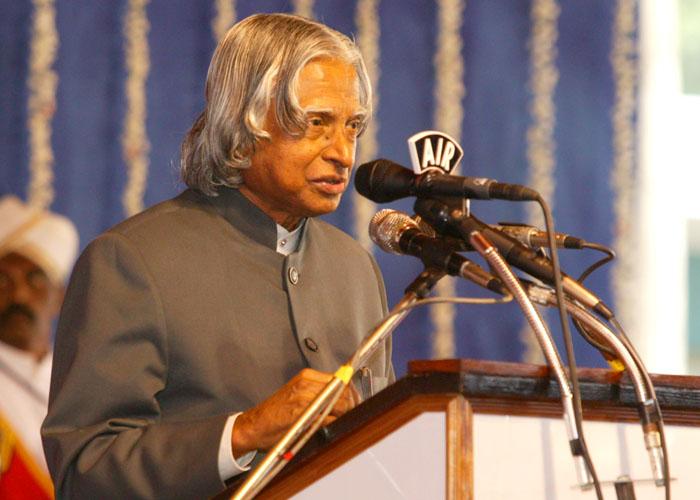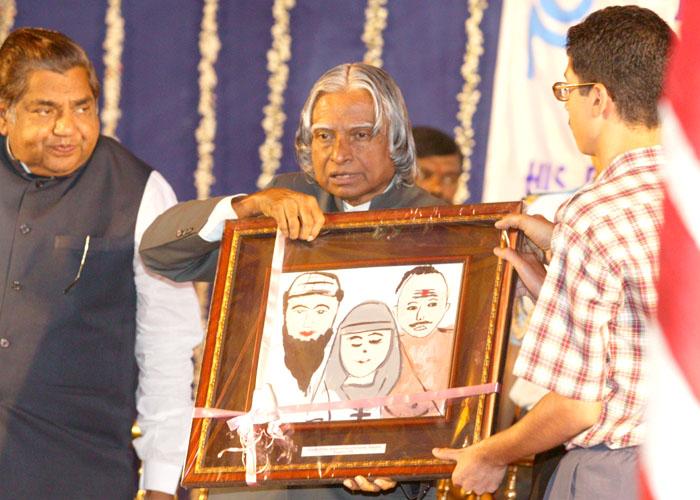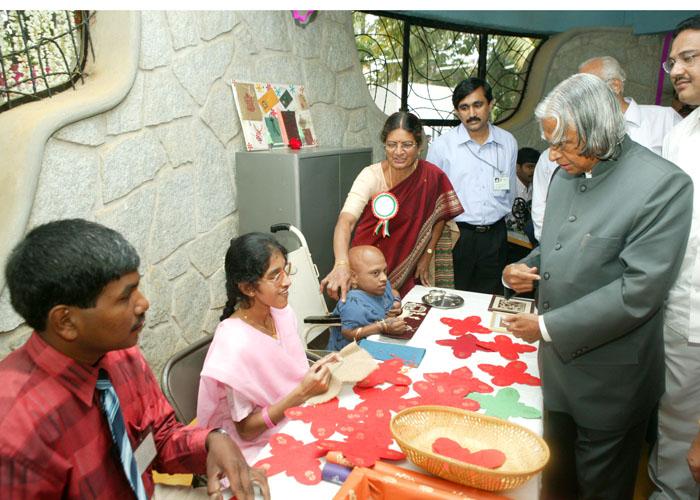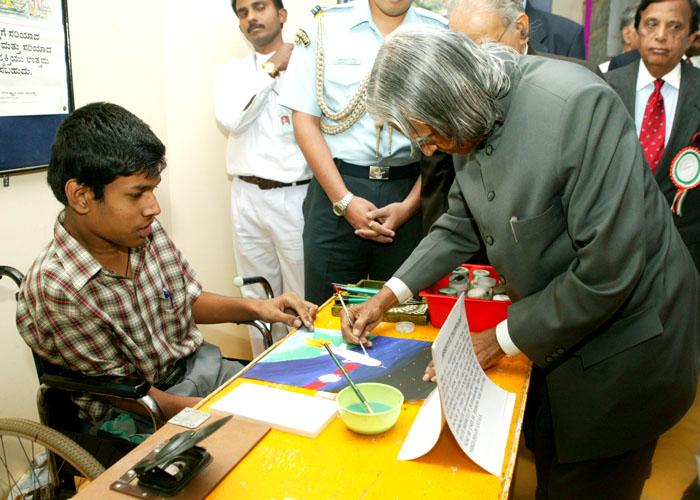Address At The Dedication Of Polytechnic Of Spastics Society Of Karnataka
Bangalore : 05-11-2004
TECHNOLOGY BRINGS SMILES TO SPECIAL CHILDREN
I am indeed delighted to participate in the dedication ceremony of Polytechnic of Spastics Society of Karnataka. I greet the organizers, members of the spastic society, doctors, paramedical staff, medical technologists, NGOs and other distinguished invitees.
Disabled population as the mission
It is estimated that in India the disabled persons constitute 5% of the total population. I would request the Ministry of Social Justice and Empowerment to work out the statistics within a year. The holistic rehabilitation of these persons involves a multi-sectoral approach and creation of a condition in which they can fully realize their potential and live their lives as independently and work and contribute. Presently it is estimated that less than 20% of the disabled population alone are brought under the purview of rehabilitation schemes. Majority of the disabled who are not receiving any rehabilitation aid or advice belong to the rural sector and they remain only under parental care and suffer the pain all through their lives. It is necessary to have counselling for the parents and relatives of the disabled and motivate them to come forward to seek the help of specialist agencies who can assist them in getting the right supportive devices and general/vocational training for their wards. In addition to providing vocational training, it is essential for government and non-governmental agencies to give psychological training for 3 to 6 months to create a spirit of ?We can do it, we will win? among the disabled persons. Combination of vocational training and the higher efforts of the disabled persons will generate the indomitable spirit. I would like to share with you some of my thoughts on this crucial human welfare mission of ?Indomitable spirit?.
Indomitable spirit
I consider that the perception of disability lies in the mind. Surely a person with a pure and enlightened mind is a valuable citizen irrespective of whether he is physically disabled or not. The life of a disabled person can be enriched through creation of indomitable spirit in them. I would like to share one example of an individual who have excelled in his field with all the disabilities.
During my visit to Bulgaria in 2003, I visited National Art Gallery of Bulgaria. There I saw an exhibition of paintings, mostly done by Bulgarian painters which inspired and impressed me. I also saw 100th birth anniversary exposition of the famous Bulgarian artist Zlatju Bojadjiev. Hundreds of paintings were done by him using right hand as is normally done. I was told that his right hand subsequently was paralyzed. But the indomitable spirit in him, made him paint using his left hand and these more beautiful paintings were also displayed. That struck me, that constructive people cannot be hampered by a physical defect, as the power comes from inside to make one to go ahead with the mission of his life.
I would like to suggest few societal and technological support missions needed for making disabled persons to live near normal life.
Disability friendly education and working place
One of the important concerns is to provide easy accessibility to public buildings, schools, colleges, banks, transport etc. I understand Delhi Metro Rail Corporation has made proper provisions for the benefit of those who are physically challenged. We should make all efforts to provide conducive working environment with easy accessibility. A tripartite approach to handle, educate and empower the disabled has to be in place with the assistance of parents, teachers and social service/health care agencies. Technological and industrial partners in this effort should aim at providing affordable devices and dependable services.
We have to make efforts to ensure that disabled persons get equal opportunities and they do not remain isolated in the society. We have to provide "equalization of opportunity" for persons with disabilities by providing seemingly simple, basic, and obvious services as access ramps and sidewalk indentations for the convenience of the disabled people. We need to realize the fact that this society is for all, encompassing human diversity and leading to development of the human potential in each person.
Assistive devices can often minimize handicaps. While we have developed many new and useful items, we need to pay attention to quality as well as at affordable cost. Research and development in this field is vital. We must harness Information Technology to improve access to the printed word for persons with visual impairment. While text in English can be scanned, transferred to the computer and heard through voice software, this facility is not yet available for the Indian languages at the speed and sophistication of English language. While material in English can easily be transcribed into Braille, this facility is not available for many of the Indian languages. Consequently, availability of text books and other reading materials in the Indian languages in Braille is scarce and production is expensive and time consuming. I suggest the IT community to device a Braille keyboard with the necessary software to convert the Braille input into text and speech in the Indian languages.
Technology for disabled
When I was in Kolkata interacting with 9000 children at the Netaji Indoor Stadium, one boy suffering from visual impairment asked me, ?Sir, what kind of education facilities are provided in the Knowledge Society, for visually handicapped children like me?? There are many like him. Let me share one thought with you. I had met many physically and mentally challenged children, visiting Rashtrapati Bhavan and also during my visits to various States and different countries. My belief all along was reconfirmed that these children like all others have an equal urge to pursue their studies and work. We have to provide solutions to their problems with the aid of Information Technology, by developing audio books, talking websites, voice assistive interfaces and other devices. We should launch programmes with IT institutions for developing aids for the visually handicapped at an affordable cost.
Belgaum experience
A seven year old boy wrote to me from Belgaum that he lost both his legs in an accident and sought my help. The boy was attended to by my friends who are specialist doctors and engineers. They took it as a mission to make the boy to walk. They brought the technology of light weight FROs and made the mission a success. The whole of Belgaum was ecstatic and approached my friends to help many more such needy children. DRDO and NIMS with the help of the local Lion?s Club facilitated fitment of light weight FROs to 315 polio affected children. This incident made me to visit Belgaum. I witnessed the beautiful scene of how human hearts of technologists and scientists have been touched by challenges of the young children.
Internet and Disabled
I visualize a scene in which some of the disabled have to become part of the Internet culture. Lack of access to the right information at the right time is a bothering concern for the disabled. Information and Communication Technology (ICT) will provide solution to make Internet friendly towards differently challenged individuals enabling them to benefit from the awesome power of the Internet. Physical mobility of the disabled may be minimized or eliminated by the virtual office concepts in which people are allowed to work from their homes through computers and deliver their work output to their offices online. Even while we work towards such near-futuristic possibilities, we should also try to provide existing services for the disabled. For example, why not provide mobile telephones at a lower cost to those who are disabled as they need it the most for regular work and his/her safety? Research challenges for recovering mentally challenged When I was a Professor at Anna University in Chennai before taking up this present assignment, apart from my teaching activities on various societal transformation missions, I was guiding a doctoral research project. My student?s name is Rev. Father A.K. George . The research was aimed to find integrated solution using a software, hardware application to achieve a near normal functioning of the brain of mentally challenged children. When I saw some of the mentally challenged children performing certain activities like singing, painting in Central Institute of Mental Retardation, Thiruvananthapuram, I got convinced that one day convergence of information and communication technology, medical electronics, bio-technology and mathematical simulation can find a solution for their problem. We have been studying the mentally challenged children in various research institutions, homes for mentally retarded and hospitals. We are confident that it will be possible to transform the functions of the damaged portion of the brain say left hemisphere to the normal portion right hemisphere of the brain by some triggering mechanism, or by implanting a bio-chip to carry-out those functions. This is a complex problem which needs an integrated approach involving medical scientists and technologists for a targeted permanent solution which can help children afflicted with this mental disability. A newer input has come to us recently through which the genes responsible for determining the chemical ingredient which create the mentally challenged state in the children could be identified. Then the Gene Chip can identify the responsible genes present in the parents and the children. Taking a blood sample, the chip should also suggest that the production of such and such chemical should be beneficial to the patient. The chip could enable, which signals, if sent would induce the brain to synthesize the required chemicals. Such signals should then be sent by the external fittings like a cell phone apparatus, to the brain. The required signals can be tested out on a culture of neuron. The signals sent by the chip or advised by the chip, should help the brain to make those chemical ingredients to make these goal achieved. When we started our research, it looked as if for solving the problem we were nowhere. But today, we have many methods of solutions coming from many researchers. Now we have to synthesize a solution leading to non-invasive treatment regime.
Women with disabilities
In every sphere of life, women with disabilities are very high. The unemployment rate for disabled women is phenomenally high. Government and Social organisations, educational institutions and industry have to work together and evolve methods for removing the high unemployment of women having disability and bring them into main stream of life by building capacity in them to make useful contribution to nation building tasks.
Rehabilitation
Rehabilitation process should aim at enabling persons with disabilities to reach and maintain their optimal physical, sensory, intellectual, psychological and/or social functional levels, thus providing them with the tools to change their lives towards a higher level of independence. Rehabilitation process has to include measures to provide and/or restore functions, or compensate for the loss or absence of a function or for a functional limitation. It should include a wide range of measures and activities from more basic and general rehabilitation to goal-oriented activities, for instance vocational rehabilitation. The most important need is to enlist people as support group personnel who have love and passion for serving others. Polytechnic for Inclusive Education created by the Spastic Society of Karnataka will meet the rehabilitation needs of the differently abled children. I understand it will cater to the needs of members of the community who have neurological impairment, hearing impairment, different abled persons with communication disorders, persons with multiple disabilities and physical disabilities. In addition their classmates would be students who have passed out from regular educational establishments and who do not have obvious disabilities. This type of inclusive atmosphere will enable the differently abled children nearly normal. At this point I would like to share my experience during my visit to Tanzania in September. There I visited a school named Uhuru Mchanganyiko Primary School which had inclusive training for the disabled children of different age groups and different disabilities. I was told that the children were really happy in this integrated environment and their learning ability got enhanced substantially.
Courage of Special children
I would like to explain an incident which took place in Rashtrapati Bhavan. On 27th November 2003. I met about 1000 differently challenged children, who were taking part in the Abilympics. They were extremely enthusiastic to visit Rashtrapati Bhavan and the environment gave them happiness. To that gathering, I recited a small poem, which runs like this: We are all God?s children,
Our minds are stronger than diamond.
We will win, win, win with our mighty will.
God is with us who can be against!
On hearing this, a boy from Iran by name Mustafa came to me, who didn?t have both legs and was fitted with artificial limbs. He thrust a paper in my hand. He had written a beautiful poem titled ?Courage?, in Persian language. It reads like this:
Courage
I don?t have legs. My mind says: Don?t weep, don?t weep For, I need not bow even in front of a King. I was really moved by the positive thinking of that boy. It shows his courage to face the life with optimism. I am sure the Polytechnic for inclusive education will provide the necessary vocational training and the emotional support to the children for living a near normal life in our society. I would now dedicate the Polytechnic for Inclusive Education established by the Spastic Society of Karnataka to the nation.
Conclusion:
We require an innovative and caring mind to provide productive employment to the disabled persons. To achieve this, a committee of experts including representatives from corporate and voluntary sectors has identified around 120 occupations at executive/management/supervisory levels and around 946 occupations at skilled / semi-skilled / unskilled levels for employing disabled persons without compromising the quality of work. Organisations and industry should voluntarily come forward to offer some of the occupations to the disabled so that they can realize their economic independence and also have the satisfaction of contributing to the cause of removing pain. Now the call centres are becoming important business centres in the country. With the minimum hardware changes through a short training programme the call centres can employ large number of visually handicapped persons for efficient work in their establishments. I would recommend call centre institutions all over the country to facilitate conduct of such courses for the disabled persons in mission mode and provide employment.
I wish you success and happiness in all your missions of providing service to the humanity. May God bless you.




